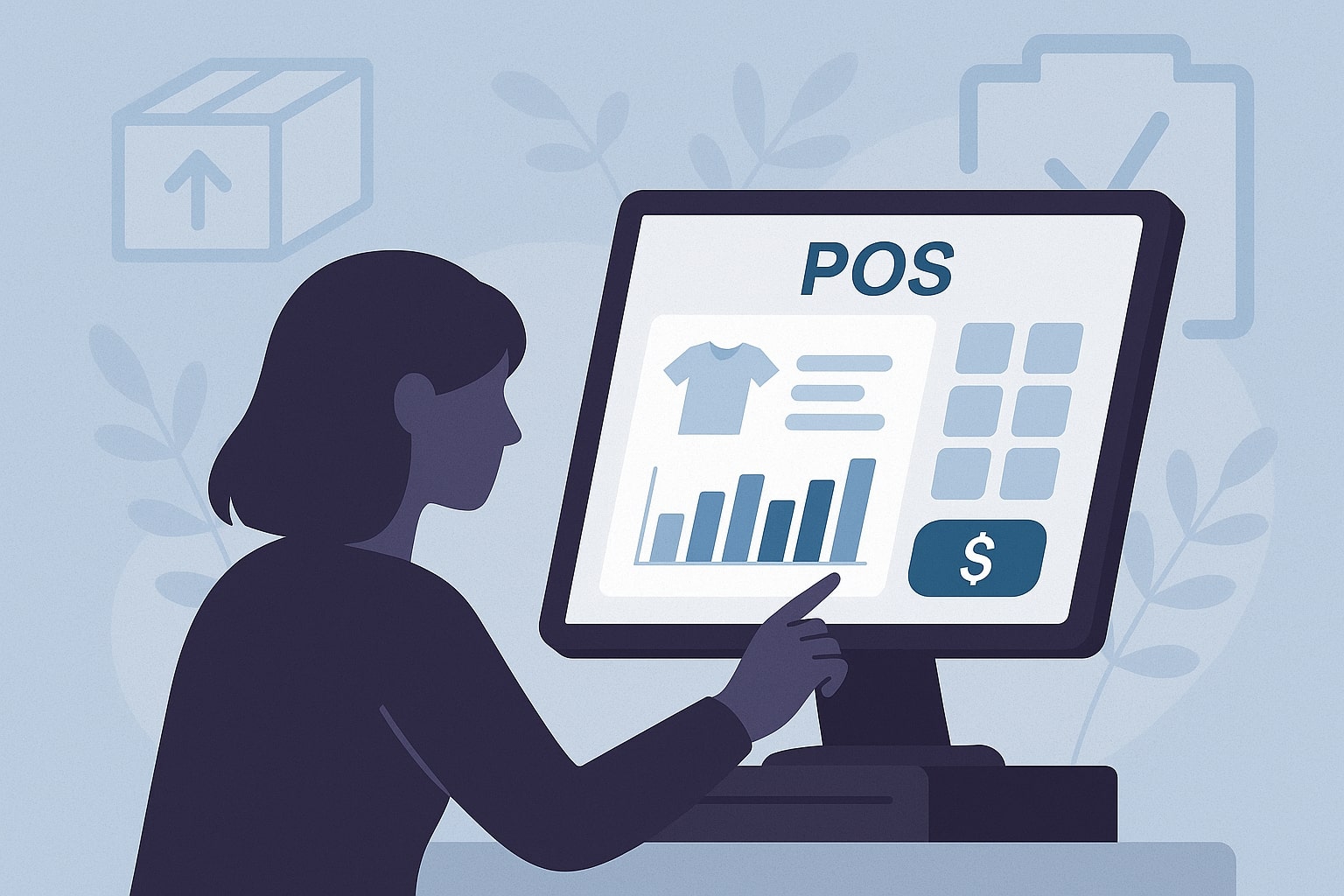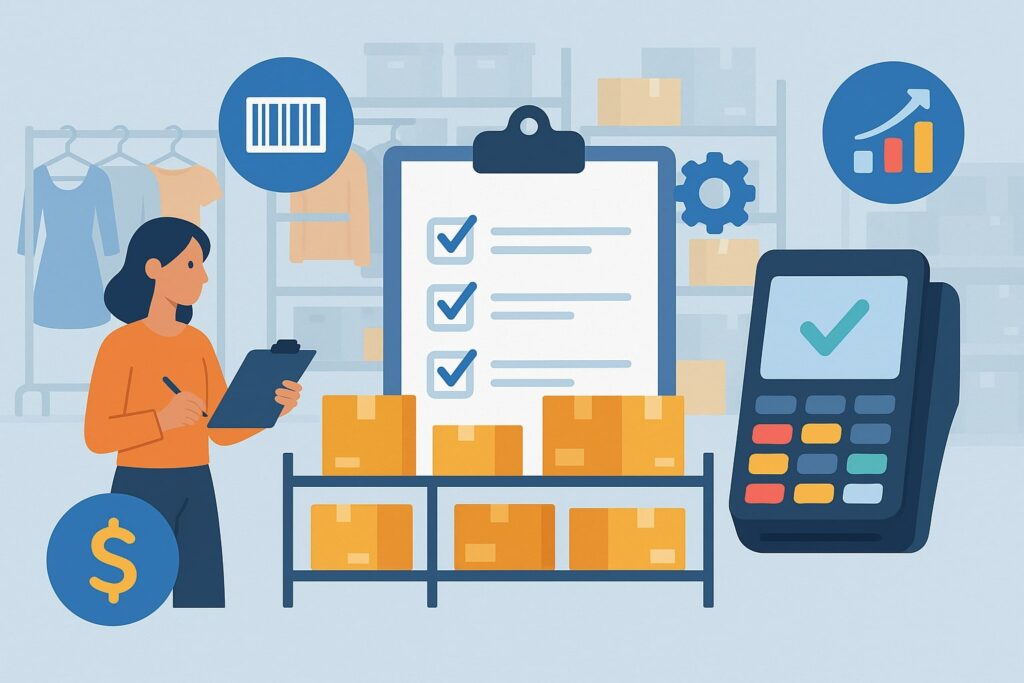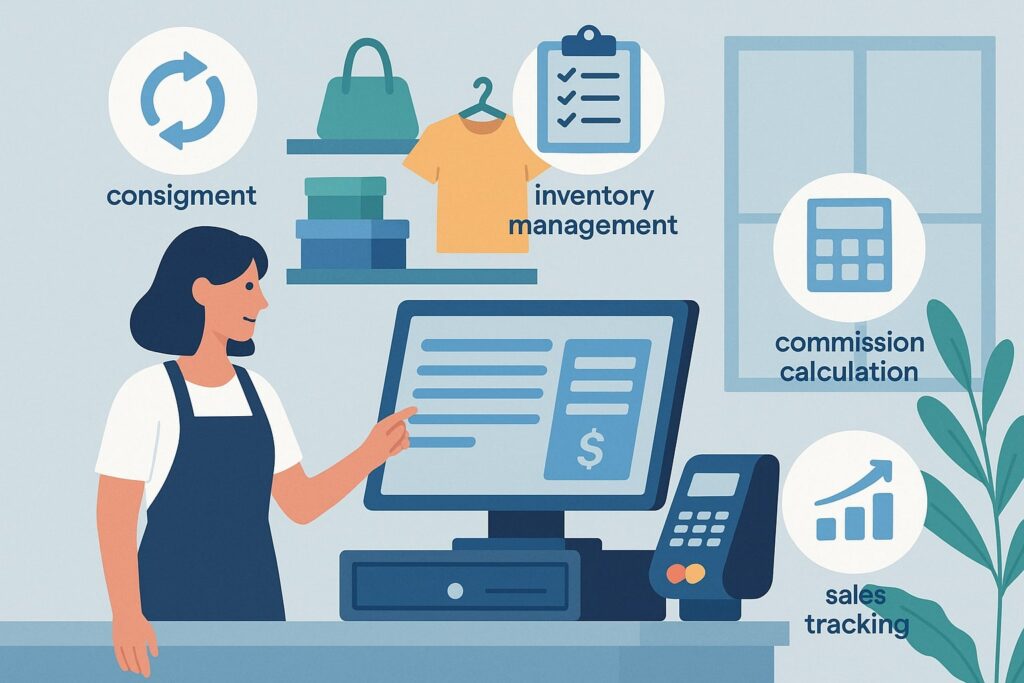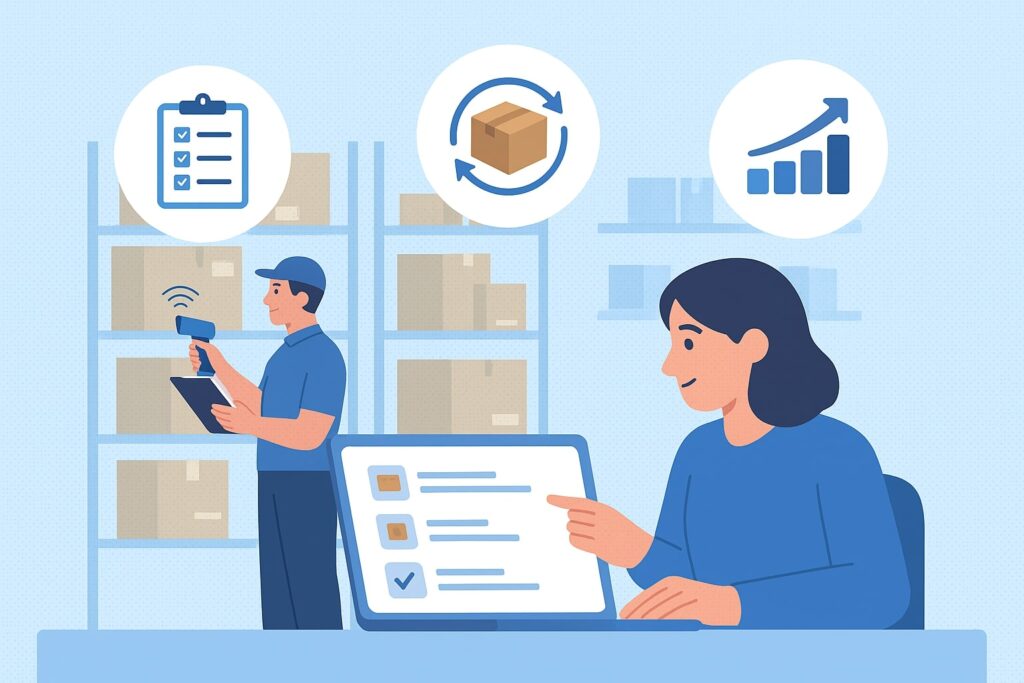
By consignmentpos September 13, 2025
Consignment inventory is a setup where a retailer sells goods it does not yet own – the supplier keeps ownership until each item sells. This means stores can offer more products without tying up capital, but tracking stock and payments becomes complex.
A POS (point-of-sale) system combines hardware (register, scanner, etc.) with software for checkout. Modern POS platforms also include inventory control features, making it much easier to manage consignment stock in real time.
In this article, we explain how to use any consignment-friendly POS to boost accuracy, save time, and optimize stock levels. All tips are general enough for any store type or POS brand.
Why Inventory Management Matters in Consignment Retail

Consignment offers big benefits and challenges for inventory control. On the plus side, consignment improves cash flow – you only pay for goods after they sell. It also boosts supplier exposure by placing their items in your store or online.
Retailers face lower financial risk because unsold items can often be returned. Working closely with consignors builds trust and better sales strategies. However, without the right tools, consignment can be hard to manage.
For example, if you lack real-time stock visibility, you can run out of popular products or overspend on slow sellers. Disputes can arise over sales data or unsold items. In short, inventory management is critical: it keeps products available for customers and prevents cash and data errors.
- Improved cash flow: You pay suppliers only after a sale, freeing up funds.
- Greater product exposure: Suppliers get premium shelf or online space for better sales.
- Lower financial risk: You can return unsold goods, reducing the chance of deadstock.
- Stronger partnerships: Consignors and retailers share data and goals, aligning marketing and sales.
Despite these upsides, manual tracking often leads to stockouts, overstocking, or payment mistakes. A modern POS helps solve these by automating and centralizing consignment data.
How a POS System Improves Inventory Management

A good POS does much more than process payments. It automatically updates inventory levels the moment an item sells. Instead of staff manually writing down stock changes, each sale or return instantly adjusts the count.
This frees employees from tedious counts and cuts human errors. POS software can also generate helpful reports: for example, you can see which items are top-sellers or which consignor’s products lag. With this insight, you can reorder or markdown at the right time.
Key POS benefits for inventory include:
- Automated inventory updates: Every sale rings down stock, saving time on counting.
- Built-in reporting: View sales trends, bestsellers, and low-stock items to plan restocking.
- Quick stock visibility: Staff can instantly check if an item is in stock on the POS screen.
- Multi-channel sync: If you also sell online or have multiple stores, a cloud POS syncs all channels so data is unified.
- Dynamic restocking: With real-time data, you can use just-in-time or reorder-point methods to minimize inventory costs.
By handling these tasks automatically, a POS helps avoid errors like overselling and gives you more time to focus on customers. In fact, stores that adopt advanced inventory tools have seen 40% faster inventory tasks and 94% better stock accuracy. Such improvements come from eliminating manual logs and having an integrated system for all consignment data.
Key POS Features for Consignment Inventory

To make the most of your POS, be aware of the features that directly aid inventory control:
- Product database: Enter every item with its name, SKU, barcode, category, and cost. With this data in the system, the POS can automatically adjust levels on each sale.
- Real-time stock tracking: When you ring up a consigned item, the POS immediately deducts it from inventory. This real-time update prevents overselling and shows which items to reorder.
- Consignor/Supplier management: Many consignment POS systems let you link each item to a consignor. The POS will track how many items of each consignor sold and calculate splits or payouts for you. (This simplifies paying consignors and keeps their inventory separate from your store-owned goods.)
- Barcode scanning: Using a scanner at checkout ensures items are registered correctly. Scanning barcodes is faster and more accurate than manual entry.
- Reporting & analytics: Look for dashboards that show inventory by category, consignor, or date. These reports help you spot slow-moving items (for markdowns) and high-turnover items (for restock).
- Multi-location support: If you have more than one store or sell online and offline, the POS should unify inventory across channels. This way you know which location holds an item. It even allows transferring stock between stores as needed.
- Cloud-based access: A cloud-connected POS means data is updated everywhere instantly. Owners and managers can check stock and sales remotely on any device. Cloud systems also backup your data automatically.
These features — many found in modern POS platforms — streamline consignment operations. For instance, cloud technology underpins real-time inventory tracking and secure data access, avoiding the silos and errors of spreadsheets.
| POS Feature | Inventory Management Benefit |
|---|---|
| Real-Time Stock Tracking | Keeps counts accurate to prevent stockouts. |
| Barcode Scanning | Speeds checkout and reduces entry errors. |
| Reporting & Analytics | Highlights top-sellers and items running low. |
| Consignor Management | Tracks consigned goods and automates consignor payouts. |
| Multi-Location Support | Balances stock across stores, avoiding shortages. |
Best Practices for Inventory Management with Your POS

A POS is a powerful tool, but you must use it well. Follow these best practices to keep consignment stock in check:
- Update entries accurately: When new consigned items arrive, enter them into the POS with correct descriptions and quantities. Include the consignor’s details so the system can match sales to the right vendor.
- Set reorder points: Use POS features to set minimum stock alerts for each item. When stock dips to that level, the system can flag it so you reorder or restock. This prevents running out of high-demand products.
- Conduct regular cycle counts: Even with automation, do scheduled physical counts (daily or weekly) to verify POS data. Manual counts catch theft, damage, or data errors. For example, POS guides recommend periodic handheld scanning or manual tallies to ensure accuracy.
- Organize inventory by category and consignor: Tag items in your POS by consignor name, category, size, or season. Well-structured data makes it easy to run reports (e.g. “show all items from Consignor A” or “find winter coats”) and ensures nothing is overlooked.
- Train your team: Make sure all staff know how to use the POS properly. They should know to scan every sale, process returns correctly, and record any damaged or returned consignment items in the system. Consistent usage keeps data reliable.
- Review sales reports: At regular intervals (daily/weekly), check which consignment items are selling and which are not. Use the POS reports to decide if unsold items need a markdown or should be returned to the consignor.
- Leverage integrations: If your POS can connect to accounting or shipping software, use those integrations. For example, export sales data for bookkeeping or sync online orders to your POS. This centralization saves time and cuts errors.
By combining POS automation with disciplined practices, consignment stores can achieve high accuracy and efficiency. As one industry report notes, adopting inventory management software can cut inventory-related tasks by up to 40% while boosting tracking precision. In practice, that means spending less time on paperwork and more on growing your business.
Table: Key POS Inventory Features vs. Benefits
| POS Functionality | Inventory Benefit |
|---|---|
| Automated Tracking | Updates stock levels on each sale, eliminating manual counts. |
| Instant Stock Alerts | Notifies staff to reorder popular items or restock moving fast. |
| Detailed Reporting | Lets you identify bestsellers and slow-movers for smart purchasing. |
| Barcode Scanning | Ensures each item is recorded correctly and quickly. |
| Consignor Accounts | Keeps consignors’ items and payouts organized. |
| Multi-Channel Sync | Shows inventory across online and in-store channels. |
Frequently Asked Questions
Q.1: What is consignment inventory?
Answer: Consignment inventory is stock that remains owned by the supplier (consignor) until the retailer sells it. The retailer (consignee) displays the goods and pays the supplier only after a sale. This lets retailers offer more products with less capital, but it requires careful tracking of unsold items.
Q.2: How does a POS system help with inventory management?
Answer: A POS system automates inventory control in real time. Every time you scan an item at checkout, the POS decrements the stock count automatically. It also generates reports on sales and inventory levels by category, location, or time.
This gives you up-to-date visibility into what’s available and what needs restocking. In short, a POS turns inventory counts and reorder checks into instant digital tasks rather than manual ones.
Q.3: What features should a consignment store look for in a POS?
Answer: Key features include real-time tracking (so you never oversell a consigned item), barcode scanning for accuracy, detailed reporting on stock and sales, and consignor management tools (to track each consignor’s inventory and splits).
It’s also wise to have multi-location support if you sell online or have multiple outlets. These features ensure you can easily log new items, monitor them on the shelf, and calculate consignor payouts without error.
Q.4: Can any point-of-sale system handle consignment inventory?
Answer: Most modern POS systems include inventory modules, but not all have built-in consignment functions. If you already have a POS, check if it allows you to assign items to consignors and handle split payments. Many generic POS systems (e.g. retail-focused platforms) can manage stock and even allow custom fields for consignor info.
If your POS lacks consignment-specific features, you may need simple workarounds (like tracking consignor in item SKUs) or consider consignment add-ons. The most important aspect is real-time inventory syncing and clear record-keeping of consigned items.
Q.5: Why is using a cloud-based POS helpful?
Answer: Cloud-based POS systems offer remote access and automatic updates. This means you can check inventory levels from anywhere (on a tablet or phone) and restock or adjust remotely. Cloud backups also protect your data against loss.
Moreover, cloud POS platforms typically sync sales immediately, so your stock counts are always current across all sales channels. Many businesses report improved security and cost savings by moving to cloud POS solutions.
Conclusion
Effective inventory management is vital for any consignment business. By leveraging your POS system’s inventory features, you can gain real-time visibility into stock, reduce errors, and streamline operations.
In fact, businesses that adopt advanced POS or inventory software often see dramatic improvements – such as cutting inventory tasks by about 40% and increasing stock accuracy by over 90%.
Whether it’s using barcode scanning to speed checkouts or configuring alerts to reorder popular items, the right POS setup transforms tedious manual work into automated processes.
Begin by entering all consignment items into the POS, tagging them clearly by consignor and category. Then use the built-in reports and alerts to make data-driven restocking and pricing decisions.
Over time, these practices will reduce waste, improve customer satisfaction (since shelves won’t run empty), and strengthen relationships with your consignors.
Every consignment store and POS platform is different, but the principles remain the same: accurate data entry, regular audits, and the intelligent use of technology. By following the tips above and choosing a feature-rich POS, you ensure that consigned inventory sells smoothly — keeping owners, consignors, and customers happy.